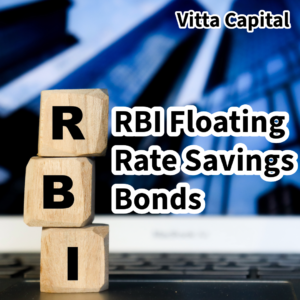
Investing in RBI Floating Rate Savings Bonds: What You Need to Know
RBI Floating Rate Savings Bonds are an excellent fixed-income investment option, providing safety and dynamic returns that adjust with prevailing interest rates. Designed for risk-averse investors, these bonds offer flexibility and guaranteed returns, making them a preferred choice for those seeking stability.
1. What Are RBI Floating Rate Savings Bonds?
These bonds are issued by the Reserve Bank of India (RBI) and are backed by the Government of India.
- Tenure: 7 years.
- Interest Type: Floating, linked to the National Savings Certificate (NSC) rate with a fixed spread.
Example:
If the current NSC rate is 6.8%, RBI Floating Rate Bonds offer a spread of 0.35%, making the interest rate 7.15%.
2. Key Features of RBI Floating Rate Bonds
A. Safety:
- Backed by the Government of India, ensuring zero credit risk.
B. Interest Rate Adjustment:
- Revised every six months based on NSC rates.
C. Minimum Investment:
- ₹1,000 and multiples thereof.
D. No Maximum Limit:
- No cap on the amount you can invest.
E. Taxable Income:
- Interest earned is fully taxable as per the investor’s income tax slab.
3. Benefits of RBI Floating Rate Bonds
A. Guaranteed Returns:
- Offers predictable income with adjustments to market rates.
B. Inflation Protection:
- Floating interest rates help protect against inflation.
C. Diversification:
- Ideal for adding stability to a diversified portfolio.
D. Accessibility:
- Can be purchased through banks like SBI, HDFC, ICICI, and more.
Example:
An investment of ₹10 lakh in these bonds at an interest rate of 7.15% would yield ₹71,500 annually, distributed semi-annually.
4. Drawbacks of RBI Floating Rate Bonds
A. Long Lock-In Period:
- Locked for 7 years, with no premature withdrawal for most investors.
- Senior citizens have limited early withdrawal options.
B. Taxable Interest:
- Interest is taxable, reducing post-tax returns for individuals in higher tax brackets.
C. No Liquidity:
- Cannot be traded or transferred in the secondary market.
5. Who Can Invest in RBI Floating Rate Bonds?
A. Eligible Investors:
- Indian residents and Hindu Undivided Families (HUFs).
B. Ideal For:
- Retirees: Seeking stable and periodic income.
- Risk-Averse Investors: Looking for government-backed safe investments.
- High Net-Worth Individuals: Diversifying portfolios with stable returns.
6. How to Invest in RBI Floating Rate Bonds
Step 1: Visit a designated bank branch or their online portal.
Step 2: Submit KYC documents: Aadhaar, PAN, and address proof.
Step 3: Make a payment through net banking, cheque, or demand draft.
Step 4: Receive the bond certificate or e-bond in your account.
Pro Tip:
Choose banks offering online platforms for easier tracking and management of your bonds.
7. How Do Floating Rates Work?
- The interest rate on these bonds changes every 6 months.
- Based on NSC rates, ensuring it reflects the prevailing market scenario.
Example:
If NSC rates rise from 6.8% to 7%, the interest on the bond adjusts to 7.35% (7% + 0.35% spread).
8. Tax Implications of RBI Floating Rate Bonds
- Interest is taxable under the “Income from Other Sources” category.
- Tax deducted at source (TDS) applies if annual interest exceeds ₹10,000.
Tax-Saving Tip:
Use the tax-saving benefits of other instruments like PPF or ELSS to offset the tax liability on bond interest.
9. Comparing RBI Floating Rate Bonds with Alternatives
| Feature | RBI Floating Bonds | Fixed Deposits | PPF |
|---|---|---|---|
| Safety | High | Medium | High |
| Tenure | 7 years | 1–10 years | 15 years |
| Interest Rate Type | Floating | Fixed | Fixed |
| Tax Efficiency | Taxable | Taxable | Tax-Free |
| Liquidity | Low | Medium | Low |
10. Should You Invest in RBI Floating Rate Bonds?
YES if you want:
- Government-backed security.
- Periodic income that adjusts with interest rate movements.
NO if you prefer:
- Liquidity and access to funds.
- Tax-free returns.
Example Scenario:
A retiree with a lump sum amount can benefit from stable and semi-annual income through these bonds, especially during times of fluctuating interest rates.
11. How to Make the Most of Your Investment
A. Invest Strategically:
- Allocate a portion of your fixed-income portfolio to these bonds for stability.
B. Monitor Interest Rates:
- Understand NSC rate trends to anticipate returns.
C. Combine with Tax-Free Options:
- Offset the tax impact by investing in PPF or tax-saving mutual funds.
Conclusion
RBI Floating Rate Savings Bonds are a reliable and safe investment for those seeking inflation-protected returns and stability. While the long lock-in period and taxable income may deter some, their government backing and dynamic interest adjustments make them a valuable addition to a well-diversified portfolio.
🔰Join our Financial Wellness Channel:-https://whatsapp.com/channel/0029VaDegyB3WHTf258XPO1m
🔰Join our Wealth Community group:-https://chat.whatsapp.com/LmhnHXUvbC19z2tEIpNqyN
For Wealth Management and Financial Planning Connect :- 9560314594
Repost ♻️ and help us to Grow together.